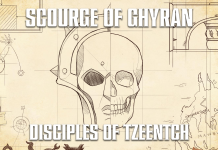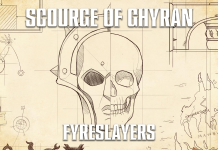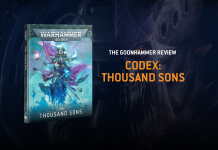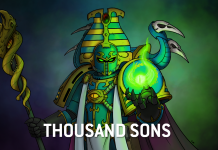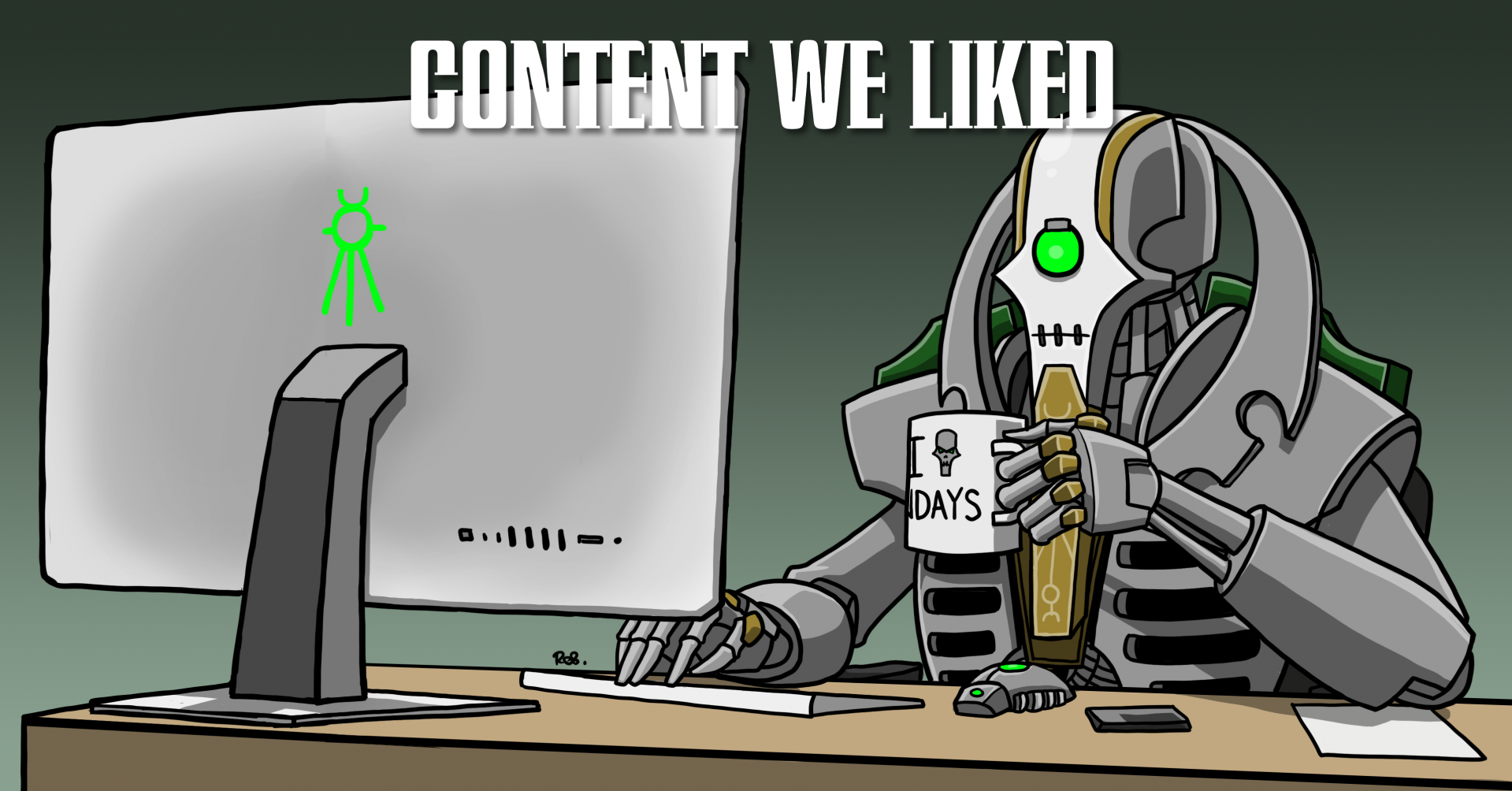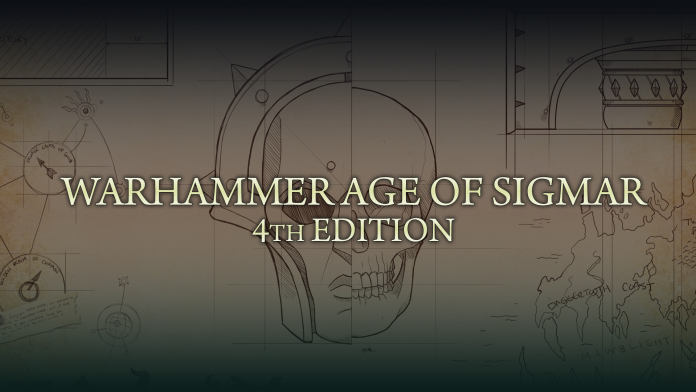If you’ve missed it, we reviewed all of the factions, the manifestations, and regiments and armies of renown. That’s been a lot of content and plenty to read through! By the time you’re reading this you’ll also be able to go and download all of the faction packs and rules, for free, from Warhammer Community dot com. Points too. There’s also going to be some general thoughts I have around list building in the new edition, so please do bear (bair) with me here.
That’s cool and all, but how do you actually write a list in fourth edition? In previous editions you had to take a hero, some “battleline” units, and then were limited up to a max of certain types of units with a lot of “other” choices that you weren’t limited to at all. Over time that developed and became more and more lenient on what you could take to fill mandatory choices.
Now we have the regiment system. If you play any other wargames this is very similar to Conquest: The Last Argument of Kings, and somewhat similar to Middle Earth Strategy Battle Game. You take heroes and those heroes can take units; sometimes they can take minor heroes.
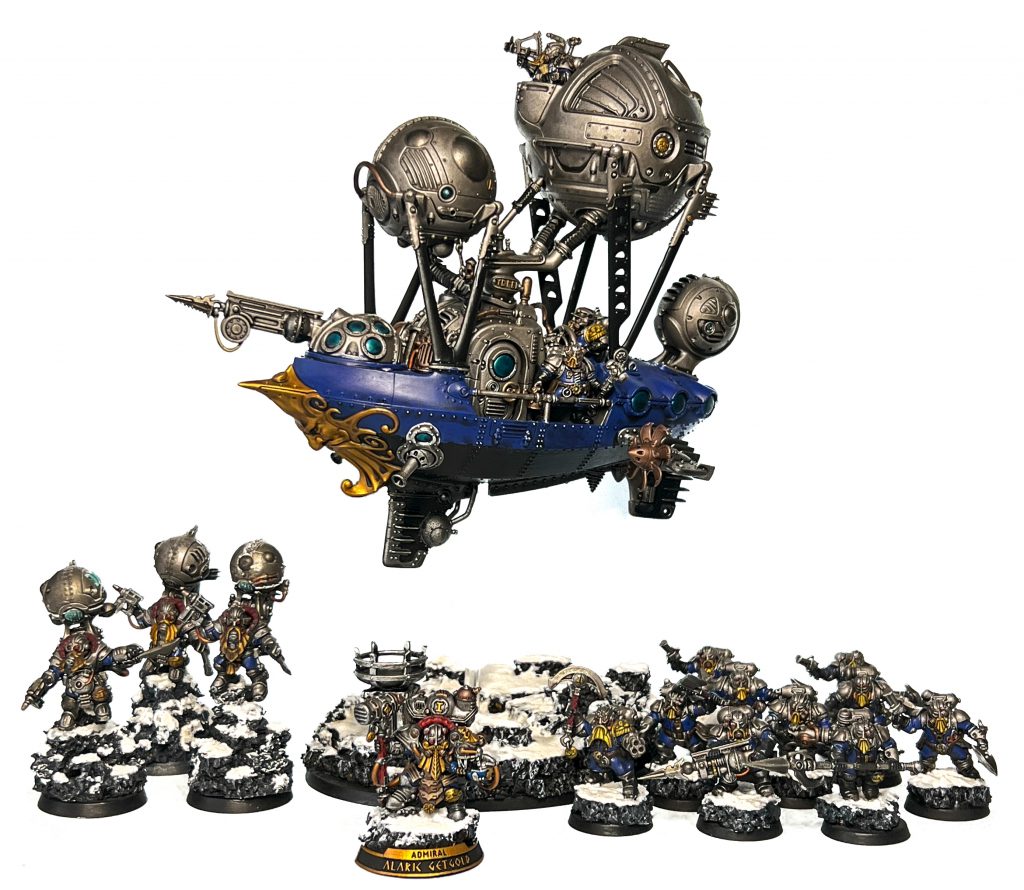
Regiments
Your army must include at least one regiment and can have up to five regiments total. A regiment is made up of one hero and up to three units. Under the Battle Profiles section you’ll see what units are allowed in each hero’s regiment. These are extremely permissive though and very rarely will you find yourself in a place where you’re not able to take a unit you’d like. Your General’s regiment can instead have up to four units, however you might not want to have many in there…more on that below.

Some heroes are able to take other heroes in their regiment, these are given a special identifier and are generally pretty rare. I was really hoping that there would be more of this and tied with specific heroes. Kharadron Overlords seem to have the most of any faction, just a bunch of book nerds reporting into their esteemed admiral. If you have a hero within a regiment under another hero you don’t start making regiment nesting dolls; that hero doesn’t get to have their own regiment within a regiment, that would be silly! They just take up one of the three (or four for a General) slots that a unit would normally take.
Warmasters
Some heroes, mainly “unique” ones like Nagash, Archaon, Skragrott etc have the “Warmaster” keyword. A Warmaster must be your army’s general and provides no positive benefit in any way, that’s all it does now. If you have multiple warmasters then you can pick which one is your general. Factions now have smaller heroes though that are warmasters like Fyreslayer Runefathers or Kharadron Overlord Admirals so watch out for the keyword at the bottom of the warscroll.
Auxiliary Units
Now, what happens if you really want to take a unit but it doesn’t fit in the regiment of any of your heroes? Or you’ve already used up all of your regiments and want more heroes? This is going to be very rare to see but it is an option for those who want it. Auxiliary units are any extra units that don’t fit into a regiment of your army and the player that has more of these awards their opponent an extra command point every turn. I cannot stress how big that is. Command points are harder to come by and you’ll be wanting as many as you can get! I have yet to find a list where I want any of these to start with, let alone taking multiple, but it’s nice to have the option.
Really, don’t do this. Unless you’re just running 18 Grimwrath Berzerkers and/or Doomseekers in which case absolutely just do that, you goddamn King.
Regiments of Renown
With allies out the window what we have left are Regiments of Renown. We reviewed these earlier and the only important thing to know here is that you can only have one in an army and it uses one of your five regiments. You cannot any other units to that regiment either.
Deploying Your Army
The number of regiments that you have directly corresponds to how many “drops” your army has. Whoever finishes deploying their army first gets to choose who takes the first turn. During deployment the players roll off to determine who starts setting up their army first. The order for deploying is simple:
- Faction Terrain
- Regiments/Units (including reserve units)
- Any other Deployment Phase Abilities
In all cases the player that’s determined to “begin deploying” first goes first, these are not separate roll offs at each step. When setting up your units you can either set up a full regiment at once or set up an individual unit. Once you’ve set up a unit from a regiment you then have to set up the remaining units individually; you cannot set up a unit or hero in one regiment and then deploy the remainder of that regiment as your next “drop”. This creates a mini game before the game between players. Having more regiments means you can deploy individual, less important, units one at a time to see where your opponent has set up and counter them. Being the player with less regiments however you don’t have to set up your full regiments either so can set up a few units individually as well, just be careful which regiments those units are coming from so you don’t suddenly have more drops by mistake!

General’s Handbook
On top of the core and advanced rules for writing your army list, working out your regiments, and setting up your army you also have the General’s Handbook to consider. This season looks like it’ll be here for the next 12 months and it’s relatively light on effecting your army construction and how it plays compared to previous handbooks and that’s great for the first season of a new edition.
What it does do however is make you question how you want to outfit your general’s regiment. As we’ve already gone through your general is the only hero that can have an additional unit in their regiment, up to four total. But do you really want to do that? Two reasons you may not want to this season are a battle tactic and the honour guard rule.
Honour Guard
After all units are set up on the table each player, starting with the player that began deploying, picks a unit in their general’s regiment to be their honour guard. Heroes do count as being part of their own regiment but you have to select a unit other than your general for this one. That unit gets to pick one of three abilities between gaining an Anti-X (+1 Rend) against a unit type of choice on the charge, reducing the number of attacks from enemies that are in combat of both the honour guard and general, and most importantly here a status +1 to hit and wound against units in the opposing general’s regiment.
I love how flexible this rule is so that you’re not locked into a bad choice for a matchup at the list building stage. You get to pick any unit in your genera’s regiment but will often already have that planned out and typically will know which ability you’re aiming to use too. Faster units like cavalry or flying monsters might want extra rend against the majority of units present, slower more defensive units will want to reduce to number of attacks coming at them and your general acting as a bodyguard. That last one though for +1 hit and wound is incredible; it’s passive and doesn’t require your general to be near the unit or even be alive! It does require your opponent to have a regiment that you’ll get to use the ability against throughout the game.
Knowing that this ability is something your opponent can choose you may want to think twice about loading up your general’s regiment with four units. Or even anything more than just a single unit to make use of the honour guard ability yourself! The more units you have in your general’s regiment the more passive +1 hit/wound you’re handing your opponent’s probably very scary unit.
Of course you could simply kill their honour guard early and not worry about it.
Slay the Entourage
One of this season’s generic battle tactics available to all players. Pick one of the unit’s in your opponent’s regiment and kill it. That simple and pairs well with “just kill their honour guard” above, look at that! Seriously though this simply existing means you need to be careful with what units are in your general’s regiment. Slotting in cheap/weak units or support heroes to this specific regiment is going to be a pretty bad idea. There are a few army-specific times when you’d have to which I’m about to tell you about but unless it’s one of these or you can only put that unit into your general’s regiment then just don’t do it!
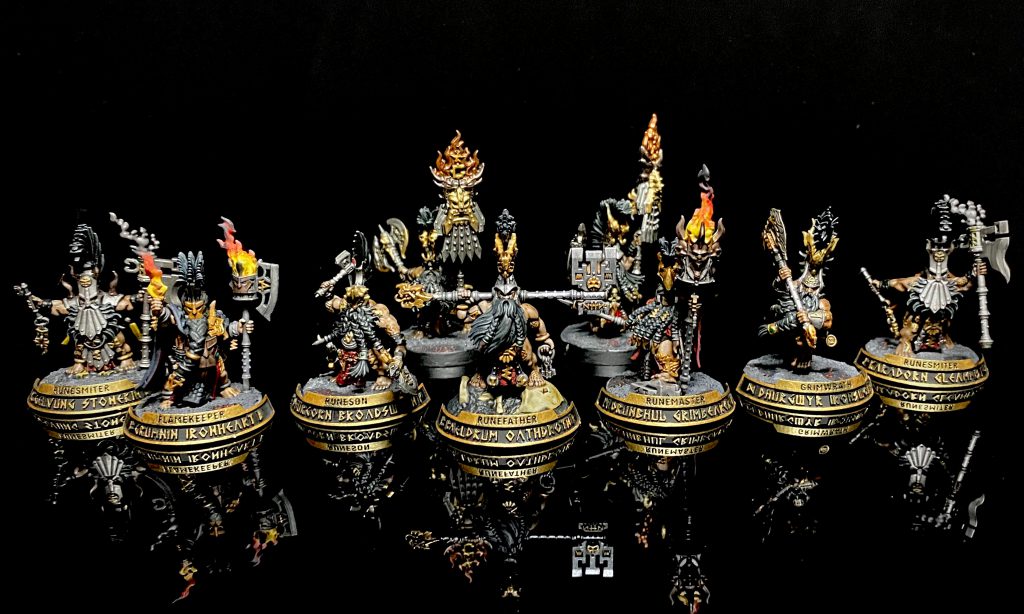
Extra Considerations
Yes, there are more! How you score across your game is always something worth thinking about, not just balancing the units based on buffs or damage output but also speed and mobility. Then there’s a couple of faction-specific cases where the units in your regiments matter.
Manifestation Lores
These are free! As part of your army list you just get to have one. Which one you take is going to be very dependant on what you have in your army, and for some armies there simply isn’t a choice either (hello Fyreslayers). We covered these in depth previously so I’m not going to talk through them one at a time here.
These are typically going to do one of two things for you: fill gaps that your army lacks or support what your army does to make them even better. Figuring out which one works best for you and your army might take a bit of practice and the “best” choice might not always be the faction’s own lore!
One example is for slower armies like Nurgle who will likely lean towards Forbidden Power. The added mobility from Soulscream Bridge for big blocks of plguebearers. Another is for any list with spellcasters that have shied away from having any big monsters to just take the Krondspine. It’s a little harder to remove than other manifestations and can throw out solid damage while just generally being in the way. I cannot stress enough how good it is to have manifestations. They can tie up enemy units, soak up damage that your actual units aren’t getting hit with, and really improve on how your army functions.
Scoring and Winning
The game is played by scoring victory points so that one player can come out on top by the end of the fifth battle round. How you score is slightly dependent on the battleplan you’re playing but in each case you need to be doing two thing: taking objectives and scoring battle tactics.
Having a very tough and/or high-damage army is great and all but if you’re not able to score objectives then the game you’re playing is “can I kill them before they score too much?” and the answer, especially in fourth edition, will typically be “no”. When you’re putting together your list consider taking a well-balanced approach of, very loosely speaking, anvils, hammers, and skirmishers. Anvils are solid, tougher to kill, higher wound count units that can sit on objectives and score you primary points. Hammers are your damage dealers that can swing in and deal with enemy units, possibly taking objectives off them as a result. Skirmishers are your faster units that don’t do either of the other roles particularly well, maybe they can swing in for some damage in a pinch, but mostly they exist for board control and to score battle tactics.
Battle Tactics
At the start of each of your turns (unless you elected to take a double-turn) you pick a battle tactic to score. Returning players will be very familiar with this process but they now score you four victory points each. You can’t choose the same one twice, regardless if you achieved it or not, so timing these is as important as anything. We’ll be going over how to score these in more depth later on but they’re important to think about during list building.
The two basic ones that you want to be thinking about in your list construction are Take the Flanks and Take Their Land. Take the Flanks requires you to have a unit within 6″ of each short table edge and not wholly within your own territory; that means you only need to have a portion of one base outside of your territory and a portion of a base within 6″ of that table edge which is very generous. Most units can achieve that with a run move but cheap, fast, skirmishing units can guarantee it. Take Their Land has you pick one piece of terrain that’s partially or wholly in enemy territory and control it. Territories are typically large and terrain will often be touching it while sticking further out into the middle of the board so while infantry may be able to run onto a piece to take a fast unit of spider riders or darkoath fellriders can get there much easier.
Kharadron Overlords
Of course the sky dwarfs are a case of exception. Has there ever been an edition where they’ve just been normal? No, absolutely not, they have their own code or something. Flying High lets one Skyvessel that hasn’t been deployed yet to be set up “in the clouds” meaning off the table to arrive during the game where you want. Only units in that Skyvessel’s regiment can join it and you can’t have already set up any other unit from its regiment. Typically this will be a Frigate or Ironclad but does force you into included units of Arkanauts, Thunderers, Skywardens, or Endrinriggers (maybe even other heroes!) in that regiment. Often that will be your Admiral since one Ironclad or Frigate in his regiment gets to use All-Out-Attack for free while he’s wholly within 12″ of it; being able to deepstrike that ship down with a free automatic +1 to hits and using his once-per-game extra attacks is a hell of an opening salvo.
Maggotkin of Nurgle
If you happen to take Gutrot Spume he allows his entire regiment to be set in reserve “aboard the Slime Fleet”. Gross. When the slime fleet arrives all units come in along a board edge with the usual “more than 9″ from enemies” restriction; those units also all have to fit wholly within 7″ of him, too, so 30-40 Blightkings isn’t going to work out. Gutrot is, sort of surprisingly, not a warmaster so does not need to be your general, and if you include a warmaster he then cannot be either limiting you to less units aboard the slime fleet. He can take any Rotbringer units (the mortal side of the army, not daemons) and up to one Lord of Blights or Lord of Plagues. All that said, Nurgle armies are typically very elite to begin with so this can be a lot of points arriving on a table edge, not near objectives (battleplan dependent) and waddling slowly over towards them.
Idoneth Deepkin
One of the Deepkin’s battle traits allows you to deploy a full regiment (and it has to be the whole regiment) in reserve “travelling the ethersea” to arrive along a board edge later in the game. However you can make that much better by taking a Soulscryer, deepstriking within 12″ of him, and setting up only 7″ away from enemies instead of the normal 9″ range. You can put the Soulscryer in that regiment, have him pop out wtihin 9″ of a board edge and more than 9″ from enemies and then pop the other units out within his rule for easy eel charges.
Summing Up and Writing Down
The biggest decision you’ll really need to make is if it’s worth having less heroes (typically) for the sake of having fewer drops on the table to choose who’s going first or if you need the utility those heroes bring. Some armies lend themselves to fewer drops much more easily than others; Kharadron Overlords and other elite armies with solid units can still do a very easy two regiment lists while Fyreslayers and support-based units will be building around 3 or more regiments.
I am very interested to see how people build their armies, if anyone is actually using auxiliary units, if there ends up being some big single regiment lists we see at tournaments, and just how this new style of building army lists shapes the meta of the game in casual and competitive scenes.
Please do leave a comment below or on whatever social media you might have seen this on to tell me how you’re shaping your lists so far, so early in the season!
Have any questions or feedback? Drop us a note in the comments below or email us at contact@goonhammer.com. Want articles like this linked in your inbox every Monday morning? Sign up for our newsletter. And don’t forget that you can support us on Patreon for backer rewards like early video content, Administratum access, an ad-free experience on our website and more.

